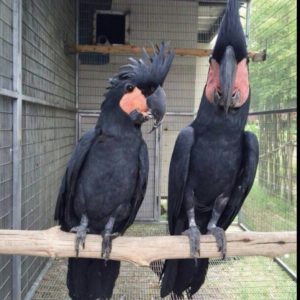Some Unique Traits Of Parrots
 Besides their wings and feathers, a major characteristic of a parrot is the beak. Parrots are very adept at using their beak, it’s almost like a hand for them. They use it to climb, hold things, manipulate things, and, of course, to eat! Beaks grow constantly, and if a parrot’s diet and habitat don’t help keep the beak worn down, it must be trimmed to prevent overgrowth.
Besides their wings and feathers, a major characteristic of a parrot is the beak. Parrots are very adept at using their beak, it’s almost like a hand for them. They use it to climb, hold things, manipulate things, and, of course, to eat! Beaks grow constantly, and if a parrot’s diet and habitat don’t help keep the beak worn down, it must be trimmed to prevent overgrowth.
Parrots have a long life span compared to many other pet species. Small birds like budgies and lovebirds aren’t considered senior until 6 years of age, cockatiels aren’t senior until around 12 years of age, and large birds like Amazons, macaws, cockatoos, and African greys aren’t considered senior until they reach around 30 years old. And parrots of all sizes can live many years as seniors. This means that adding a parrot to your family is a commitment for many years.
Parrots are birds, and female birds can lay eggs whether or not a male bird is present; eggs just don’t hatch if unfertilized. Season and environment affect breeding activity. Consult your avian veterinarian for information on what to expect regarding egg laying with your parrot’s species.
A bird’s crop is a temporary storage pouch that’s located along the esophagus between the mouth and proventriculus/stomach. The crop is useful, but it’s also subject to crop disease or impaction.
Birds have feathers and feathers molt (shed). This means that new feathers are needed to take the place of lost feathers. That’s where blood feathers come in. Blood feathers are actively growing feathers. They are shorter than mature feathers and have a softer shaft that’s reddish, blue, or black near the base instead of being white. If a growing feather is bent or cut, it could bleed. Sometimes, blood feathers will break and bleed if a bird falls or thrashes about inside the cage. In this case, you’ll have to pull the feather out from its root to get it to stop bleeding. Ask your avian veterinarian how to handle the situation if your bird suffers a broken blood feather.
Wing feather trims must be done with care. Never trim blood feathers. It’s a good idea to leave feathers on either side of a blood feather intact, which will help protect it.
As mentioned before, parrots have zygodactyl feet. These allow them to grip and climb. Perches are important to parrot foot health. Providing numerous perches in and out of the cage with the proper diameter and various textures promotes good foot health. So, too, does keeping the nails trimmed. Regularly trimming nails also minimizes scratches you might suffer while holding your parrot. Your avian veterinarian or a professional bird groomer can perform nail trims or show you how to do it.
The upper side of the tail of most parrots has a two-lobed gland called the uropygial gland, also called the preen gland. It’s known to produce a secretion that parrots use in grooming. The secretion reacts with sunlight or full-spectrum light to produce vitamin D3 that parrots ingest during grooming. Vitamin D3 is necessary for good health. Some people speculate that the secretion also aids birds in differentiating the gender of other birds. Birds can make their feather water resistant by rubbing oils from their preen gland onto their feathers, which is why often see a bird rub its head on the base of its tail and then rub its head along its feathers. Parrots that notably lack a uropygial gland are Amazons and the macaws in the genera Anodorhynchus and Cyanopsitta.
Parrots’ eyes are laterally placed (on the side of their head), which gives them a larger field of vision but also creates a blind spot directly in front of their beak. They also have monocular vision, where only one eye is focused on a particular object. Parrots can also voluntarily contract their pupils (referred to as eye pinning), whereas our pupils and those of other mammals dilate automatically to light levels and some medications. Eye pinning can indicate a parrot’s mood; rapid eye pinning usually indicates excitement.

